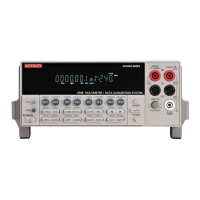Calibration 2-9
3. Perform the steps listed in Table 2-3 to complete DC volts calibration. For each calibra-
tion step:
• Set the calibrator to the indicated value, and make sure it is in OPERATE.
• Press the ENTER key to calibrate that step.
• Wait until the Model 2700 finishes each step. (The unit will display the
CALIBRATING message while calibrating.)
NOTE If your calibrator cannot output the values recommended in Table 2-3, use the left and
right arrow keys, and the up and down range keys to set the Model 2700 display value
to match the calibrator output voltage.
Resistance calibration
Completing the 100V DC calibration step ends the DC voltage calibration procedure. The
Model 2700 will then prompt you to connect 1kΩ. Follow these steps for resistance calibration:
1. Set the calibrator output for resistance, and turn on external sense.
NOTE Use external sense (4-wire Ω) when calibrating all resistance ranges. Be sure that
the calibrator external sense mode is turned on.
2. Perform the calibration steps summarized in Table 2-4. For each step:
• Set the calibrator to the indicated value, and place the unit in operate. (If the cali-
brator cannot output the exact resistance value, use the Model 2700 left and right
arrow keys and the range keys to adjust the Model 2700 display to agree with the
actual calibrator resistance.)
• Press the ENTER key to calibrate each point.
• Wait for the Model 2700 to complete each step before continuing.
Table 2-3
DC volts calibration summary
Calibration step Calibrator voltage Allowable range
+10V
-10V
100V
+10.00000V
-10.00000V
+100.0000V
+9V to +11V
-9V to -11V
+90V to +110V
Table 2-4
Ohms calibration summary
Calibration step Calibrator resistance* Allowable range
1kΩ
10kΩ
100kΩ
1MΩ
1kΩ
10kΩ
100kΩ
1MΩ
0.9kΩ to 1.1kΩ
9kΩ to 11kΩ
90kΩ to 110kΩ
0.9MΩ to 1.1MΩ
*Nominal resistance. Adjust Model 2700 calibration parameter to agree with actual value.

